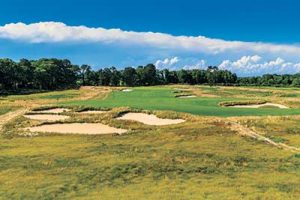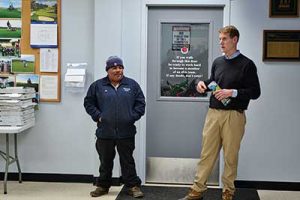An inside look at Shinnecock Hills GC

The 9th hole of Shinnecock Hills Golf Club in Southampton, N.Y.
Jon Jennings is on a streak
The two-time Boston Marathon qualifier (2005, 2006) has run every day since Jan. 1, 2015. That’s a streak of 1,566 straight days and counting. He runs at least a mile a day, sometimes 6 miles, sometimes as many as 10 miles.
It’s not like he lives in an ideal climate for such a streak. With four Nor’easters just this winter and spring, Long Island, N.Y., has experienced its fair share of rough weather. Cold running conditions don’t bother him. Hot conditions don’t either. The only thing that might bother him is the thought of not running — of not sticking to the regimen.
“I’m not a free-flow person,” Jennings says. “I do like structure.”
A commitment to structure, coupled with an uncanny eye for detail, earned Jennings the position at Shinnecock Hills in 2012. His lifelong friend Pat Sisk, CGCS at Milwaukee CC, wasn’t at all surprised by Jennings’ success.
“Agronomic skills are one thing, many of us possess agronomic skills,” Sisk says. “It’s his organizational skills, the ability to plan and communicate among 10,000 different avenues… that’s what separates guys who can handle these majors from the also-rans.”

No. 3 at Shinnecock Hills.
The day Jennings accepted the job at Shinnecock he achieved a golf historian’s dream: He left a job at one of the five founding member clubs of the United States Golf Association (Chicago Golf Club, founded 1893, the oldest 18-hole golf club in America) for another one of the five founding clubs (Shinnecock Hills’ original 12 holes date back to 1892; its clubhouse, the oldest in America, was built the same year).
“It still gives me chills when I’m out there on the golf course thinking that I’m actually at Shinnecock,” Jennings says. “I knew it would be an amazing place to work… I never thought that I’d actually be here.”
Restoring a classic
The U.S. Open returns to Southampton, N.Y., and Shinnecock Hills next month (June 11-17). This will be the fifth time in three different centuries the course plays host to the tournament (1896, 1986, 1995 and 2004), and it will host again in 2026.
Shinnecock, the No. 4 best course in the U.S., according to Golf Digest, made some changes to the layout since the 2004 U.S. Open. Using photos from the era, the course is now restored to what William Flynn designed for the links course in 1931. The original shape of the greens has been reclaimed, as well as tees, along with the removal of trees that had popped up over the decades.
“This project goes back decades,” Jennings says, acknowledging his predecessors at the course. “Pete Smith started it with the greens committee by taking out trees and clearing out those vistas. Mark Michaud continued it with some green expansions and continuing the tree removal. With the Open coming in 2018, it really provided the catalyst for the project.”

Angel Vallespil has worked at Shinnecock since 2003, and serves as golf course foreman.
Jennings and his crew took meticulous steps to narrow some fairways with the beautiful wispy fescue grasses for which Shinnecock is famous. Another delicate project coincided with the long-term tree removal project — a tree addition project to the north side of the property, using trees from the course to create a natural fence between the course and houses. Lastly, perimeter areas of the course that were scattered with woods, new growth over the last few decades, were removed to recapture as much of the golfing grounds as possible.
And the course will play 443 yards longer (now 7,439 yards), with 10 newly built back tees. The result is a course with epic views that can be deceptive at times in how far the eye can see.
Bring on the best players in the world.
“It’s getting back to how the course looked if you would have come out here in the late 1800s when people first started playing golf here, that open look, where you have scruffy native areas and sand. Back then, steam locomotives were going up and down the island and embers would come off them and regularly burn everything down,” Jennings says. “The vision of the course is to be able to look across and have vast expanses of these open vistas that you can just see from anywhere. You have the hospitality tents on 16, now you have something that provides scale, and these tents are huge (and) the golf course still looks big. You can look across and almost see a mile in distance across it. That’s what we wanted to recreate.”
Flynn’s fescue
Tightening fairways at some courses means simply changing mowing lines. But Shinnecock Hills is not just some course.
It takes about three seasons to get fescue rough to establish, Jennings says. Longer if the course has an expectation of perfection. That means lots of hand-watering to make sure there are no voids and that the grass has the proper consistency.
“The fairway project was a lot of man hours, eight people, probably 36 hours a day, hand-watering,” says Assistant Superintendent Lindsay Brownson. “Some of our fairways are still being taken care of in New Jersey.”
The turf removed from fairways will have to enjoy the Garden State for a bit longer. This fescue rough looks too good — like it has been here for 50 years. In truth, it probably has.
It occurred to Jennings to identify areas where grandstands would be built for the Open, hiding the turf underneath, and strip rough from those areas to be transplanted where fairways were to be tightened. This work was done over the past few seasons, but to those who don’t see the course every day, it looks as if it has been like this since William Flynn’s time at the club.
Like the fescue rough, the trees removed from the interior of the course also were reused. They were planted on the north fence line with a 90-inch spade. But those trees — eastern red cedars and black pines — won’t last forever, nor will they look natural unless saplings are brought in.
Nature always fills a void, and trees are popping up in the areas that were cut down to expand the course. If the crew spots a sapling cedar in the rough, they dig it up with a shovel, so it can be planted among the big trees.
“I wouldn’t call it a challenge,” Jennings says of the restoration and the many moving parts it entailed, “but it’s something that definitely requires a lot of patience and oversight.”
By the rules
Oversight is something Jennings could have mastered in at the University of Massachusetts-Amherst (he has an associate degree in golf course management and a bachelor’s in resource economics).
But patience?
Senior Assistant Superintendent Michael Ford first worked for Jennings during his days at the Chicago Golf Club. “He’s pretty disciplined, an intense guy to work for,” he says. “He’s a very driven individual — it takes a little getting used to, his personality. We have a good working relationship, obviously, because I’ve stuck around.”
There’s a sign on the door that enters into the shop at Shinnecock, and it reads, “If you walk through this door be ready to work hard to become a member of an elite team. If any doubt, don’t enter!”
“I come from a background of a wide variety of golf courses, but nothing this extreme,” says Assistant Superintendent Brownson. “There were 14-hour workdays, and this seemed like another level. Jon challenges you on a professional level, on a technique level. It’s challenging but it’s rewarding as well.”
“It’s an intense attitude here,” echoes Assistant Superintendent Bobby Bolin, a small-town Nebraska farm kid who fell in love with golf, graduated from the University of Nebraska and moved to Long Island three seasons ago specifically for the 2018 U.S. Open. “It’s hard, but I grew up with long hours — in the summers I’d work 80 hours in construction, then go home and farm after that.”
Office Manager Ana Alvarez likes the working environment because it reminds her of her old job as a water technician… in the Marines. “It’s good, it’s challenging — (Jennings) likes everything to be perfect,” Alvarez says. “I was in the military, so I’m used to everything being done by the rules.”
Michael Ford has seen some great golf in his young career. He took his passion for golf and for the outdoors and married the two, returning to turf school at the age of 24. He’s spent time maintaining turf at the Country Club of Rochester, TPC Boston, Oak Hill, Chicago Golf Club and now Shinnecock. Ford has a unique understanding of Jennings based on his experience.
“He has such a broad eye for detail,” Ford says. “Something you wouldn’t think is important? It is important to him. He doesn’t leave a stone unturned. There is a learning curve, but I’ve gotten to the point that I can work ahead of him and understand what he’s looking for out on the golf course. His eye for detail, across the board, is amazing.”
Jennings relates a story about coming home from work on a Saturday afternoon when he was in Chicago. His wife, Susan, had been planting and arranging flowers on the back patio, including a centerpiece that had vines cascading down to the ground.
She asked Jennings if he noticed anything different about the back patio. He replied, “Yeah, your geraniums are a little dry.” She shook her head in disbelief and said, “I feel sorry for you.”

The downhill par 4 No. 14 was stretched out to 519 yards.
A pretty good pace
“It’s almost a curse, but it’s helped me be successful in what I do,” Jennings says about his fierce attention to detail. “I’m looking for something that’s wrong, all the time, everywhere I go. And by doing that, I’m going through the golf course and looking for something that’s out of place, or not right, and I’m bringing people in to correct it.”
Pat Sisk has known Jennings since middle school. They eventually both ended up at UMass. Jennings got Sisk into turf, Sisk got Jennings into distance running.
“He’s about the most organized guy I know, and he’s always been motivated,” Sisk says. “He’s the type of guy, when he gets his mind put to something, he goes at it with blinders on. His success in the industry is proof that if you really dedicate yourself, good things happen.”
Jennings says he is proud of his career path but admits there have been some sacrifices. He missed some of the kids’ games. He came home after everyone was in bed more than a few times. It’s a matter of coming to terms with yourself and who you want to be, he says.
And Jennings clearly wants to be right here, counting down the days to the 2018 U.S. Open.
“Being in metropolitan New York, the pace and the tension and, I’ll call it the stress of the area, really suits my personality,” Jennings says. “I like that kind of wound-up, anxious feeling all the time. These things fit together — my personality, the area and the level that we’re requested to keep the golf course.”
But what can stop the Running Man? Is there ever a finish line? Maybe buy a boat and retire one day? His son, currently attending the University of Minnesota, is an accomplished sailor.
Jennings shrugs. It might be the only question for which he doesn’t have an answer.
“I have no idea. I’m going to be that guy that just keeps… I don’t know. Who knows? I’ll probably have to do something,” he says. “My wife says I should never retire. I’m not a good relaxed person. Even on vacation I like to keep things going at a pretty good pace. But if you define fun by something that suits your personality and something you enjoy doing, then yeah… I’m having fun.”
There are 2,920 running days until the 2026 U.S. Open at Shinnecock. Maybe it’s time to start a new streak.
Photos: USGA/John Mummert (1, 2, 4); Seth Jones (3)










